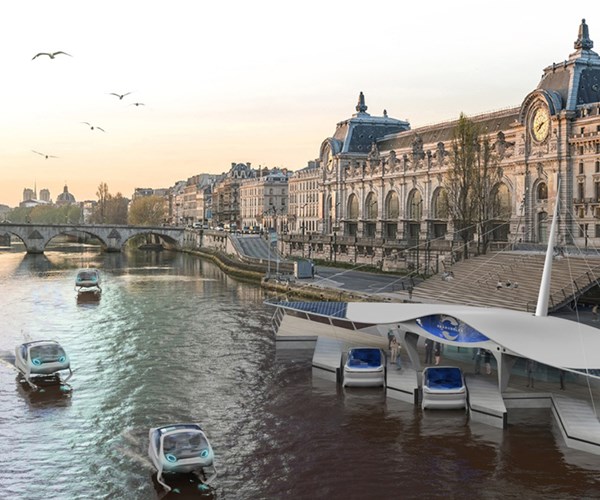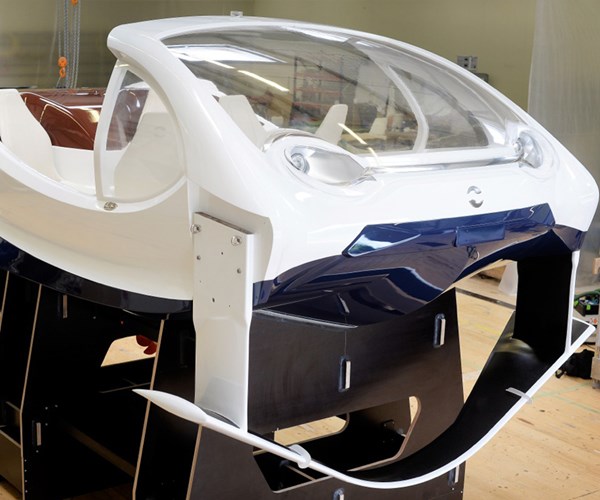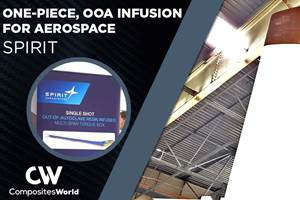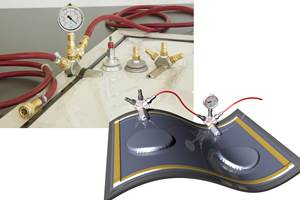Coming soon to the urban waterways: SeaBubbles
All-composite hydrofoiling watercraft will, if SeaBubbles has its way, soon be taxiing people across urban waterways in more than 50 cities across the world.

SeaBubbles concept, Paris, France.
SeaBubbles (Paris, France) is a company and a project. The project is the brainchild of hydrofoiling yachtsman Alain Thébault and champion windsurfer Anders Bringdal. Their vision of creating an eco-conscious taxi transport solution for the world’s urban waterways has come to fruition with the support of composites Décision SA (Ecublens, Switzerland) and Sicomin Epoxy Systems (Chateauneuf les Martigues, France) a formulator and supplier of high-performance epoxy systems.
SeaBubbles are based on a hydrofoil design that allows the watercraft to glide silently above the water when it exceeds 12 kph/7.5 mph. A clean charging electric drive system converts solar, wind and water power so the vessel does not generate any CO2 emissions.
Décision SA, part of the Carboman group, working with SeaBubbles and Sicomin, has so far completed the first of five SeaBubbles water taxi prototypes and these were launched in June 2017 on the River Seine in Paris. The boats were delivered in record time with material specification, design analysis and production achieved in less than four months. Décision is now on track to produce the remaining four prototypes that will also be in service in Paris starting in September 2017.
Décision faced a particularly daunting challenge with this project in that it was particularly important to focus on future production and not just the initial prototypes. To match the ambitious growth plans of the SeaBubbles team, it was vital to consider a robust, sustainable and cost-effective serial production route from the outset.

SeaBubbles prototype.
Working alongside the SeaBubbles team, Décision analyzed the initial design and delivered production-ready tooling and a production-ready composites manufacturing process.
In addition to satisfying the composite engineering targets for weight and stiffness, Décision’s manufacturing process was also required to include a significant percentage of bio-based materials. For material development, Sicomin was chosen because of its history as a formulator and supplier of a range of bio-based epoxy resins, natural fibers and core materials.
All of the SeaBubbles composite parts are produced using a vacuum infusion process where the sandwich structure comprising of reinforcement fibers and a natural cork core are infused with Sicomin’s GreenPoxy InfuGreen810 advanced resin system.
InfuGreen 810 contains 30% carbon content that is derived from plant-based origins. It also has extremely low viscosity at room temperature. Sicomin has formulated the advanced bio product to support manufacturers producing parts for mass production using injection or infusion techniques and the system is available with a variety of hardeners, making it suitable for small to very large components. InfuGreen 810 also holds DNV GL certification providing extra assurance of the products quality, efficiency and safety standards.
Sicomin also supplied a range of complementary materials to provide a package of infusion-specific products including glass fiber multiaxial fabrics, PVC foams with bespoke perforation patterns for infusion, release agents and epoxy spray adhesives to securely position dry fabrics in the molds.
“SeaBubbles has unified a group of companies with eco-friendly ambitions to create a truly innovative concept in transportation. Décision has been the perfect development customer with their experience of creating exceptional quality and performance parts whilst using a wide range of bio-based epoxy resins, natural fibres and core materials. The SeaBubbles team provided us all with a vision to follow,” comments Philippe Marcovich, president of Sicomin.
SeaBubbles reports it is committed to providing its water taxi service at the cost of regular taxi journey and plans to operate in 50 cities within the next five years. Following on from the success of this first phase of the project, a larger 15-seater vessel is also planned for construction later this year.
Related Content
VIDEO: One-Piece, OOA Infusion for Aerospace Composites
Tier-1 aerostructures manufacturer Spirit AeroSystems developed an out-of-autoclave (OOA), one-shot resin infusion process to reduce weight, labor and fasteners for a multi-spar aircraft torque box.
Read MorePlant tour: Albany Engineered Composites, Rochester, N.H., U.S.
Efficient, high-quality, well-controlled composites manufacturing at volume is the mantra for this 3D weaving specialist.
Read MoreSmartValves offer improvements over traditional vacuum bag ports
Developed to resolve tilting and close-off issues, SmartValves eliminate cutting through vacuum bags while offering reduced process time and maintenance.
Read MorePEEK vs. PEKK vs. PAEK and continuous compression molding
Suppliers of thermoplastics and carbon fiber chime in regarding PEEK vs. PEKK, and now PAEK, as well as in-situ consolidation — the supply chain for thermoplastic tape composites continues to evolve.
Read MoreRead Next
Developing bonded composite repair for ships, offshore units
Bureau Veritas and industry partners issue guidelines and pave the way for certification via StrengthBond Offshore project.
Read More“Structured air” TPS safeguards composite structures
Powered by an 85% air/15% pure polyimide aerogel, Blueshift’s novel material system protects structures during transient thermal events from -200°C to beyond 2400°C for rockets, battery boxes and more.
Read MoreVIDEO: High-volume processing for fiberglass components
Cannon Ergos, a company specializing in high-ton presses and equipment for composites fabrication and plastics processing, displayed automotive and industrial components at CAMX 2024.
Read More






















